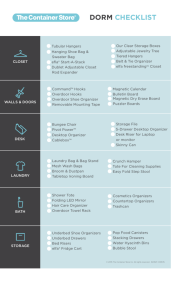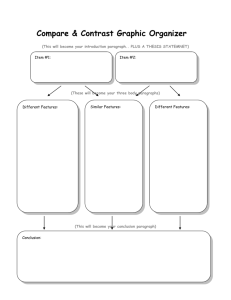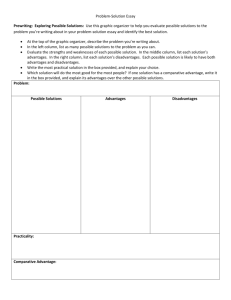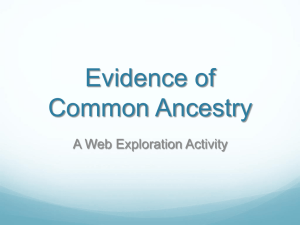File
advertisement
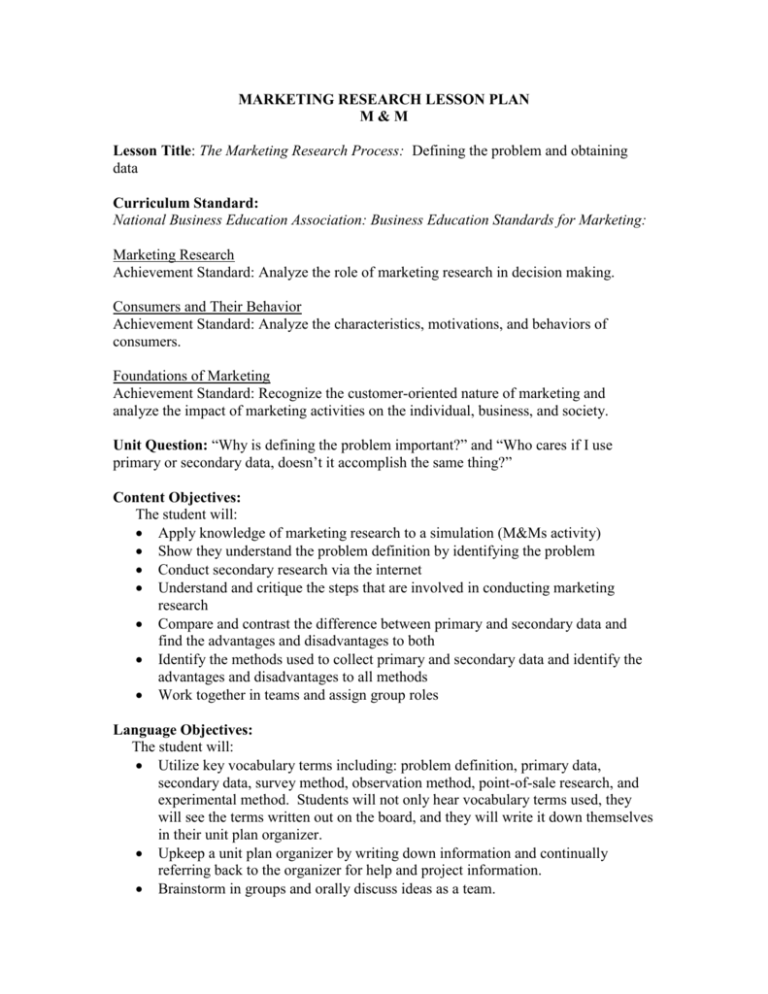
MARKETING RESEARCH LESSON PLAN M&M Lesson Title: The Marketing Research Process: Defining the problem and obtaining data Curriculum Standard: National Business Education Association: Business Education Standards for Marketing: Marketing Research Achievement Standard: Analyze the role of marketing research in decision making. Consumers and Their Behavior Achievement Standard: Analyze the characteristics, motivations, and behaviors of consumers. Foundations of Marketing Achievement Standard: Recognize the customer-oriented nature of marketing and analyze the impact of marketing activities on the individual, business, and society. Unit Question: “Why is defining the problem important?” and “Who cares if I use primary or secondary data, doesn’t it accomplish the same thing?” Content Objectives: The student will: Apply knowledge of marketing research to a simulation (M&Ms activity) Show they understand the problem definition by identifying the problem Conduct secondary research via the internet Understand and critique the steps that are involved in conducting marketing research Compare and contrast the difference between primary and secondary data and find the advantages and disadvantages to both Identify the methods used to collect primary and secondary data and identify the advantages and disadvantages to all methods Work together in teams and assign group roles Language Objectives: The student will: Utilize key vocabulary terms including: problem definition, primary data, secondary data, survey method, observation method, point-of-sale research, and experimental method. Students will not only hear vocabulary terms used, they will see the terms written out on the board, and they will write it down themselves in their unit plan organizer. Upkeep a unit plan organizer by writing down information and continually referring back to the organizer for help and project information. Brainstorm in groups and orally discuss ideas as a team. Distinguish between the class’s definition of the marketing research process and the textbooks definition of the marketing research process by finding similarities and differences through utilizing a Venn diagram. Take notes in a framed outline format. Learning Strategy Objectives: Metacognitive Strategy: Allow each student to read the introduction scenarios to themselves prior to getting in their groups. While students read have them ask themselves questions, self-monitor their reading, and make predictions of whether or not they think the small business owner should add another line, and if so how they will do this. Cognitive Strategy: Students will use various tools to help themselves understand concepts (Venn diagrams, unit plan organizer, and framed outline note taking format) Social/Affective Strategy: Students will be working in groups to collaboratively finish parts one and two of the M&M activity. Students will assume group roles (team recorder, materials collector/timekeeper, and the team reporter) throughout the duration of the activity. Time Needed: 90 min Materials Needed: M&Ms marketing research handout: parts 1 & 2 Computers with internet access for each group of students Overhead projector White board Unit plan organizer sheet One bag of M&Ms Background Knowledge: Within this lesson students will be asked to use their prior knowledge of marketing research, business trends, target markets, and demographics in order to gain access and further insight into the material. These concepts have been covered in previous classes and works well as a bridge to new information. The Unit Plan organizer also aids in background knowledge by evaluating what the class already knows with what they will learn. The M&M Marketing Research simulation helps students to understand the concept of marketing research by taking an object that students are familiar with, M&Ms. Students will be able to connect what they already know about M&Ms (colors, peanut, plain, crispy, melts in your mouth, not in your hand, etc) with information given to them through a class discussion and group activities. Comprehensible Input: Appropriate Speech: Teacher will enunciate his/her words and slow the rate of speech during lecture time. The teacher will also use vocabulary words as much as possible when speaking to students so they will hear these words multiple times throughout the lesson. Guided practice will be used while students fill out their unit plan organizer. As always avoid idioms when lecturing. Explanation of Academic Tasks: Introduce group activities to class as a whole before distribution of materials. Have teacher give explicit instructions of what he/she wants from each group and model the steps to help create scaffolding for the students. Use of Techniques: Two hands-on learning activities will be used within this lesson. Students will work with their peers and cooperatively work with one another. Teacher will model for groups and use body language to help convey meaning. While introducing the M&M activity, the teacher will use realia (a bag on M&Ms) to help students make connections. Teacher will open bag of M&Ms to show different colors and count how many are in the bag. Additionally students will have the M&M website and handouts as a visual representation of what they will be doing. Anticipatory Set/Introduction: Introduce an activity where students, in groups of 3 to 4, are given various scenarios regarding small business owners wanting to expand their business by adding a new product or line. Ask students to brainstorm how the small business owner should determine whether or not to add the additional line. (Students should use their prior knowledge of marketing research types and trends, target markets and demographics in order to come to their conclusions.) Teams then share with the rest of the class their ideas on how the small business owner should go about conducting the marketing research. Teacher will then introduce the 5 steps of marketing research according to the textbook, and ask students to compare and contrast their model to the books model. Students will fill out a Venn diagram to find similarities and differences (Time needed: 15-20 min) Steps: 1. See anticipatory set/introduction (15-20 min) 2. Teacher will handout a unit plan organizer sheet out to all students in the classroom. As a class they will (with guided instruction from the teacher) fill out the sheet so they will have a clear understanding of what they have done, what they are currently doing, and where they are going. This form will also aid in creating a timeline, a study tool, and an organizer for students thoughts. This form can also be a place to highlight key vocabulary that will be used within the unit. (15 min) 3. Teacher will further discuss the first two steps in the marketing research process: Defining the Problem and Obtaining the Data in a mini lecture format. Students will take framed outline notes from overheads. Key vocabulary terms to note include: problem definition, primary data, secondary data, survey method, sample, observation method, point-of-sale research, and experimental method. As a class we will discuss the advantages and disadvantages to primary and secondary data as well as the advantages and disadvantages of the survey method, observation method, and experimental method. (20 min) 4. Teacher will introduce the M&Ms marketing research activity parts one and two to the class. In doing so he/she will open a bag of M&Ms to show students the different colors of M&Ms and count up how many M&Ms are in the bag, this will then lead the class into defining the problem and obtaining secondary data. In this activity students are given the two problems: 1. Does each bag of M&Ms contain the same number of candies? 2. How many of each color M&M is in each bag? They then, in groups of 3, will go on the M&Ms website to conduct secondary data research. The M&M activity handout has a list of questions that the students need to answer before the end of class. While in their groups they will establish group roles of the team recorder, materials collector/timekeeper, and the team reporter. (30 min) Assessment: Informal – exit slip question: “In the M&M activity were you conducting primary or secondary research?” Closure: Have students turn in exit slip
